Evaluating Soil Health: Earthworms, Flora, Fauna, Enzymes & SOM
VerifiedAdded on 2023/06/04
|7
|1509
|189
Discussion Board Post
AI Summary
This discussion post delves into the critical components of soil health assessment, focusing on earthworms, flora, fauna, soil enzymes, and soil organic matter (SOM). It explores the beneficial roles of earthworms in enhancing soil fertility through nutrient availability and improved drainage, while also acknowledging complexities related to exotic species. The discussion emphasizes the importance of both flora and fauna in maintaining ecological balance and soil fertility, highlighting the contributions of wading bird guano and leguminous plants. Furthermore, it examines the role of soil enzymes in accelerating the decomposition of plant residues and increasing nutrient content, with a focus on methods for detecting enzyme activity. Lastly, the post addresses the significance of SOM in providing nutrients and increasing water holding capacity, while also noting that it is not the sole indicator of soil fertility, which depends on complex interactions. Desklib provides access to similar solved assignments and past papers for students.
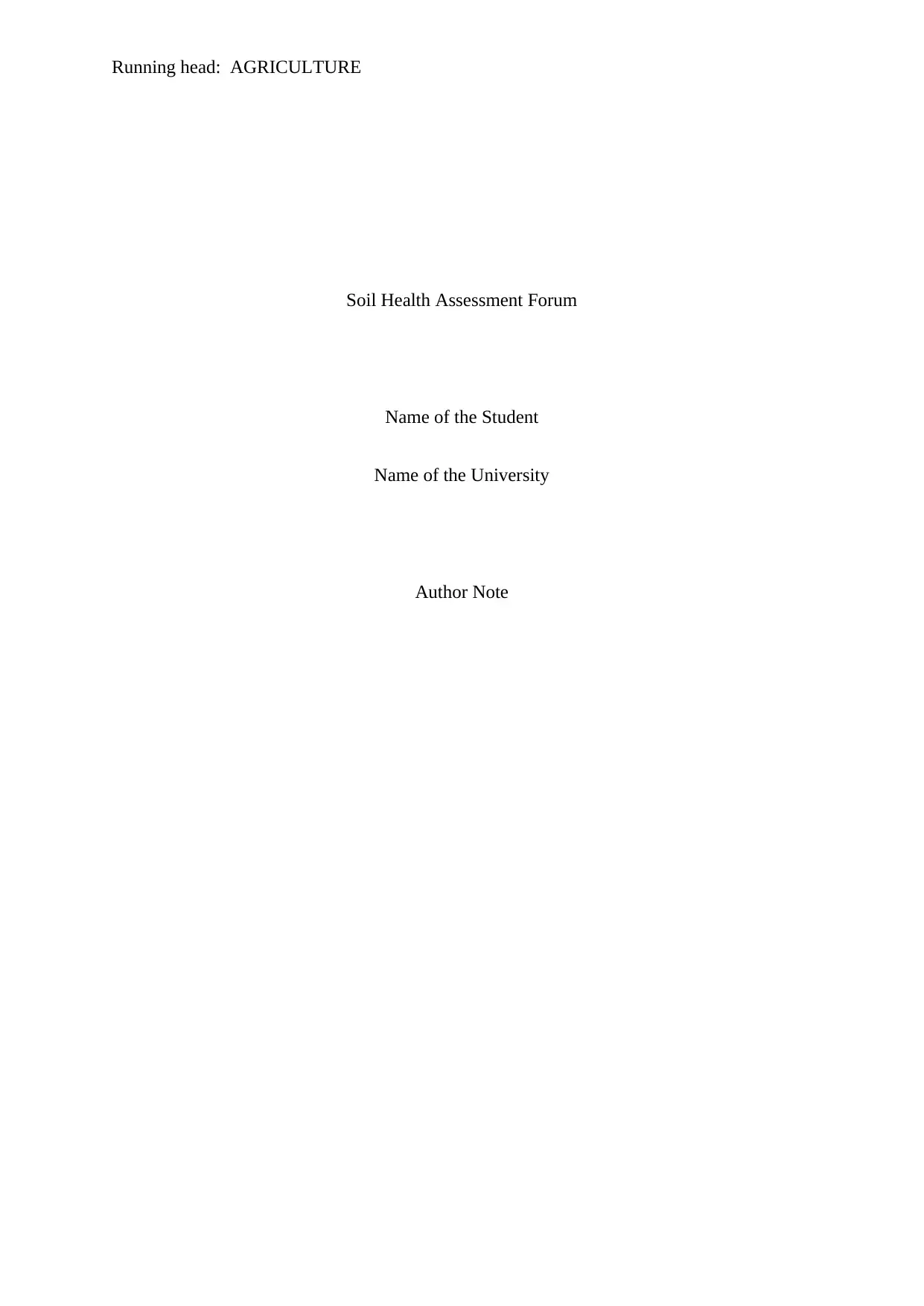
Running head: AGRICULTURE
Soil Health Assessment Forum
Name of the Student
Name of the University
Author Note
Soil Health Assessment Forum
Name of the Student
Name of the University
Author Note
Paraphrase This Document
Need a fresh take? Get an instant paraphrase of this document with our AI Paraphraser
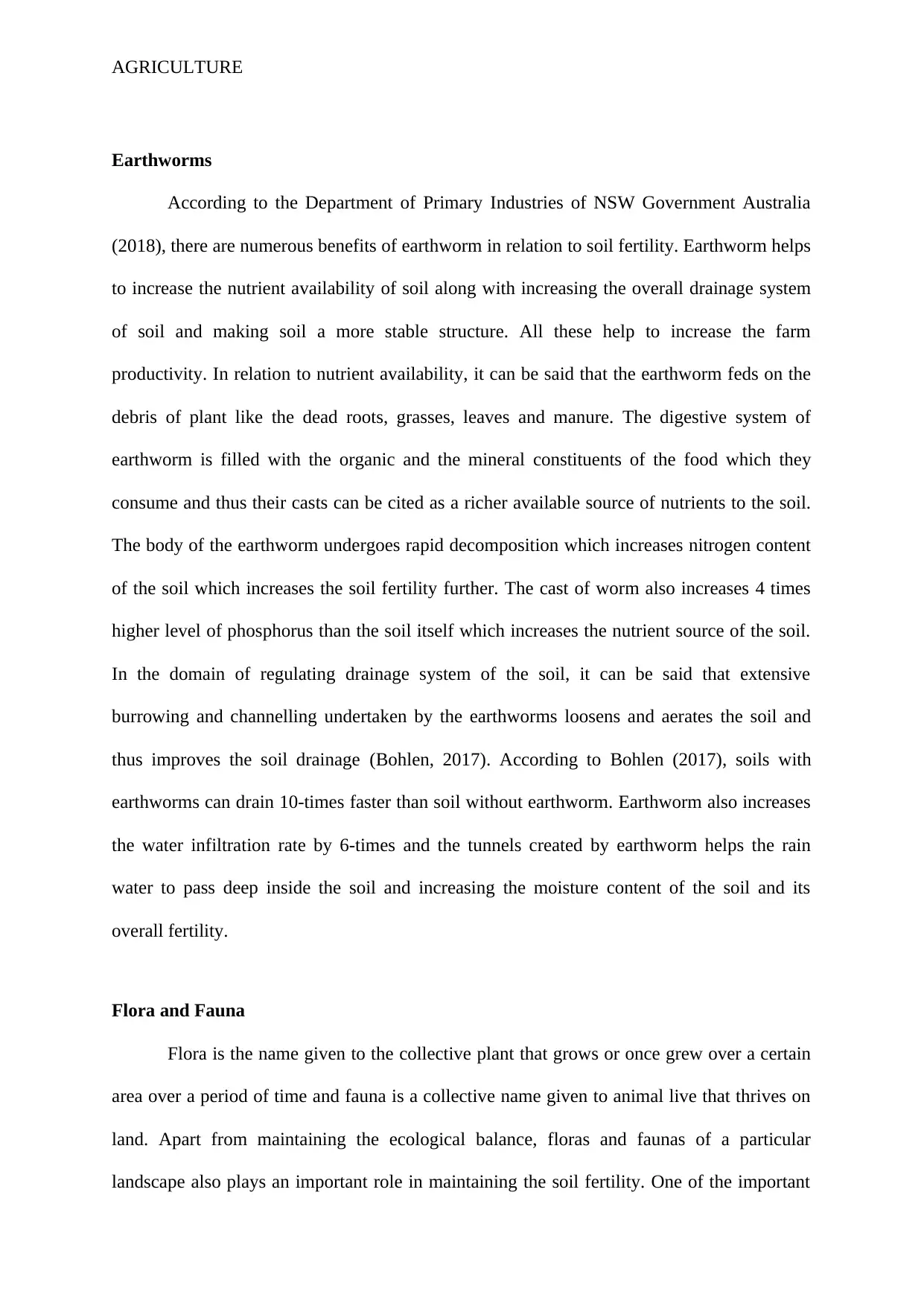
AGRICULTURE
Earthworms
According to the Department of Primary Industries of NSW Government Australia
(2018), there are numerous benefits of earthworm in relation to soil fertility. Earthworm helps
to increase the nutrient availability of soil along with increasing the overall drainage system
of soil and making soil a more stable structure. All these help to increase the farm
productivity. In relation to nutrient availability, it can be said that the earthworm feds on the
debris of plant like the dead roots, grasses, leaves and manure. The digestive system of
earthworm is filled with the organic and the mineral constituents of the food which they
consume and thus their casts can be cited as a richer available source of nutrients to the soil.
The body of the earthworm undergoes rapid decomposition which increases nitrogen content
of the soil which increases the soil fertility further. The cast of worm also increases 4 times
higher level of phosphorus than the soil itself which increases the nutrient source of the soil.
In the domain of regulating drainage system of the soil, it can be said that extensive
burrowing and channelling undertaken by the earthworms loosens and aerates the soil and
thus improves the soil drainage (Bohlen, 2017). According to Bohlen (2017), soils with
earthworms can drain 10-times faster than soil without earthworm. Earthworm also increases
the water infiltration rate by 6-times and the tunnels created by earthworm helps the rain
water to pass deep inside the soil and increasing the moisture content of the soil and its
overall fertility.
Flora and Fauna
Flora is the name given to the collective plant that grows or once grew over a certain
area over a period of time and fauna is a collective name given to animal live that thrives on
land. Apart from maintaining the ecological balance, floras and faunas of a particular
landscape also plays an important role in maintaining the soil fertility. One of the important
Earthworms
According to the Department of Primary Industries of NSW Government Australia
(2018), there are numerous benefits of earthworm in relation to soil fertility. Earthworm helps
to increase the nutrient availability of soil along with increasing the overall drainage system
of soil and making soil a more stable structure. All these help to increase the farm
productivity. In relation to nutrient availability, it can be said that the earthworm feds on the
debris of plant like the dead roots, grasses, leaves and manure. The digestive system of
earthworm is filled with the organic and the mineral constituents of the food which they
consume and thus their casts can be cited as a richer available source of nutrients to the soil.
The body of the earthworm undergoes rapid decomposition which increases nitrogen content
of the soil which increases the soil fertility further. The cast of worm also increases 4 times
higher level of phosphorus than the soil itself which increases the nutrient source of the soil.
In the domain of regulating drainage system of the soil, it can be said that extensive
burrowing and channelling undertaken by the earthworms loosens and aerates the soil and
thus improves the soil drainage (Bohlen, 2017). According to Bohlen (2017), soils with
earthworms can drain 10-times faster than soil without earthworm. Earthworm also increases
the water infiltration rate by 6-times and the tunnels created by earthworm helps the rain
water to pass deep inside the soil and increasing the moisture content of the soil and its
overall fertility.
Flora and Fauna
Flora is the name given to the collective plant that grows or once grew over a certain
area over a period of time and fauna is a collective name given to animal live that thrives on
land. Apart from maintaining the ecological balance, floras and faunas of a particular
landscape also plays an important role in maintaining the soil fertility. One of the important
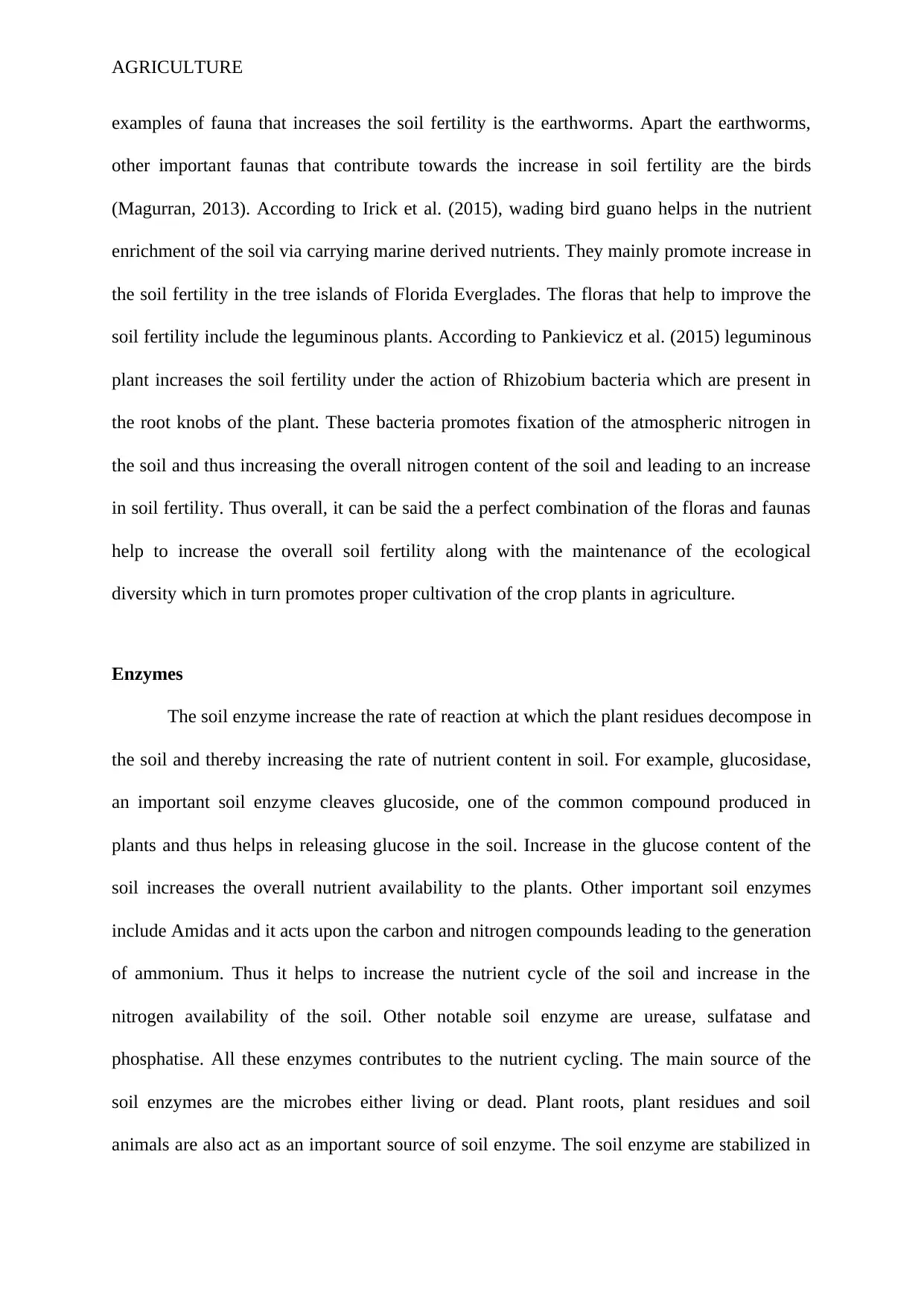
AGRICULTURE
examples of fauna that increases the soil fertility is the earthworms. Apart the earthworms,
other important faunas that contribute towards the increase in soil fertility are the birds
(Magurran, 2013). According to Irick et al. (2015), wading bird guano helps in the nutrient
enrichment of the soil via carrying marine derived nutrients. They mainly promote increase in
the soil fertility in the tree islands of Florida Everglades. The floras that help to improve the
soil fertility include the leguminous plants. According to Pankievicz et al. (2015) leguminous
plant increases the soil fertility under the action of Rhizobium bacteria which are present in
the root knobs of the plant. These bacteria promotes fixation of the atmospheric nitrogen in
the soil and thus increasing the overall nitrogen content of the soil and leading to an increase
in soil fertility. Thus overall, it can be said the a perfect combination of the floras and faunas
help to increase the overall soil fertility along with the maintenance of the ecological
diversity which in turn promotes proper cultivation of the crop plants in agriculture.
Enzymes
The soil enzyme increase the rate of reaction at which the plant residues decompose in
the soil and thereby increasing the rate of nutrient content in soil. For example, glucosidase,
an important soil enzyme cleaves glucoside, one of the common compound produced in
plants and thus helps in releasing glucose in the soil. Increase in the glucose content of the
soil increases the overall nutrient availability to the plants. Other important soil enzymes
include Amidas and it acts upon the carbon and nitrogen compounds leading to the generation
of ammonium. Thus it helps to increase the nutrient cycle of the soil and increase in the
nitrogen availability of the soil. Other notable soil enzyme are urease, sulfatase and
phosphatise. All these enzymes contributes to the nutrient cycling. The main source of the
soil enzymes are the microbes either living or dead. Plant roots, plant residues and soil
animals are also act as an important source of soil enzyme. The soil enzyme are stabilized in
examples of fauna that increases the soil fertility is the earthworms. Apart the earthworms,
other important faunas that contribute towards the increase in soil fertility are the birds
(Magurran, 2013). According to Irick et al. (2015), wading bird guano helps in the nutrient
enrichment of the soil via carrying marine derived nutrients. They mainly promote increase in
the soil fertility in the tree islands of Florida Everglades. The floras that help to improve the
soil fertility include the leguminous plants. According to Pankievicz et al. (2015) leguminous
plant increases the soil fertility under the action of Rhizobium bacteria which are present in
the root knobs of the plant. These bacteria promotes fixation of the atmospheric nitrogen in
the soil and thus increasing the overall nitrogen content of the soil and leading to an increase
in soil fertility. Thus overall, it can be said the a perfect combination of the floras and faunas
help to increase the overall soil fertility along with the maintenance of the ecological
diversity which in turn promotes proper cultivation of the crop plants in agriculture.
Enzymes
The soil enzyme increase the rate of reaction at which the plant residues decompose in
the soil and thereby increasing the rate of nutrient content in soil. For example, glucosidase,
an important soil enzyme cleaves glucoside, one of the common compound produced in
plants and thus helps in releasing glucose in the soil. Increase in the glucose content of the
soil increases the overall nutrient availability to the plants. Other important soil enzymes
include Amidas and it acts upon the carbon and nitrogen compounds leading to the generation
of ammonium. Thus it helps to increase the nutrient cycle of the soil and increase in the
nitrogen availability of the soil. Other notable soil enzyme are urease, sulfatase and
phosphatise. All these enzymes contributes to the nutrient cycling. The main source of the
soil enzymes are the microbes either living or dead. Plant roots, plant residues and soil
animals are also act as an important source of soil enzyme. The soil enzyme are stabilized in
⊘ This is a preview!⊘
Do you want full access?
Subscribe today to unlock all pages.

Trusted by 1+ million students worldwide
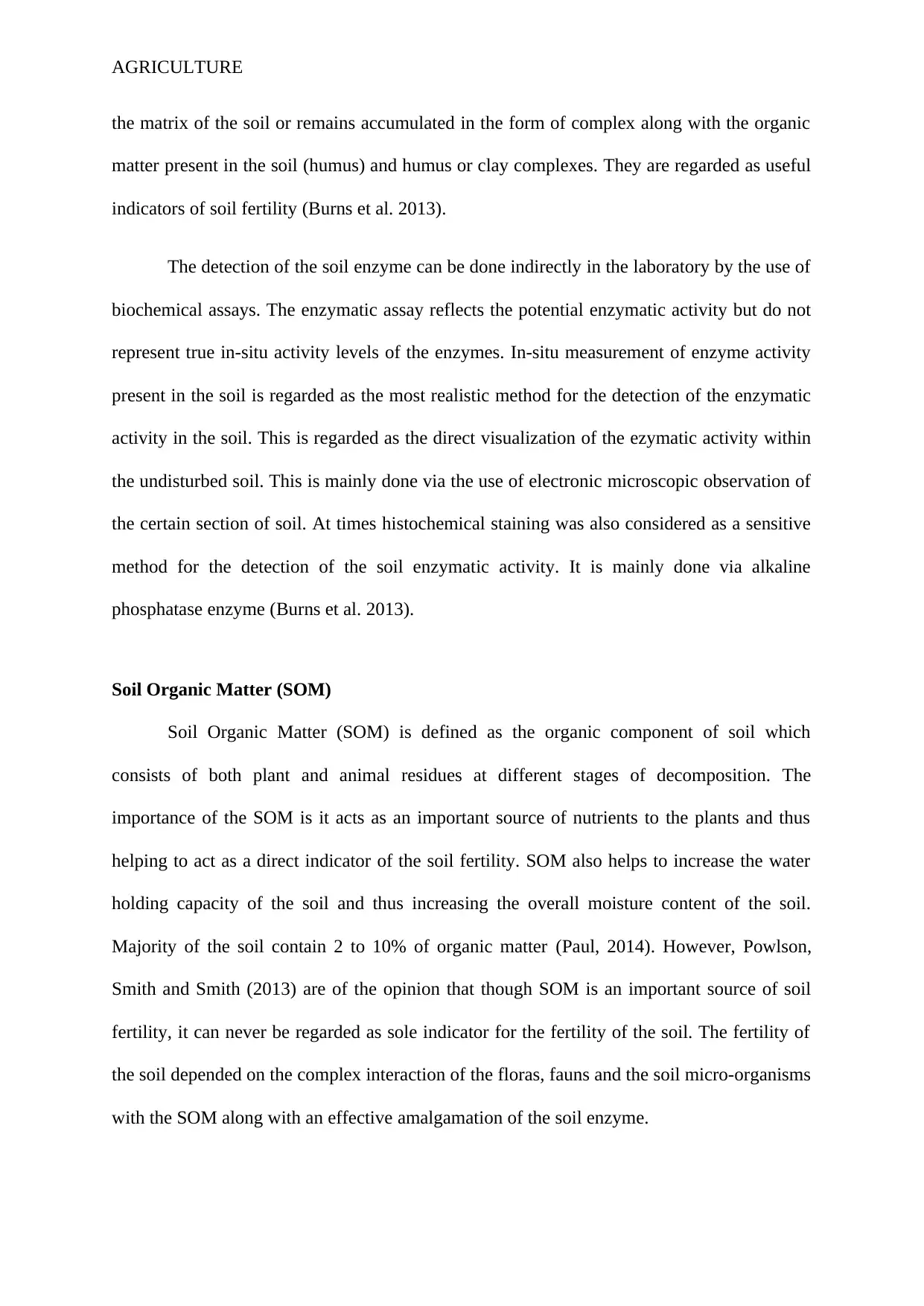
AGRICULTURE
the matrix of the soil or remains accumulated in the form of complex along with the organic
matter present in the soil (humus) and humus or clay complexes. They are regarded as useful
indicators of soil fertility (Burns et al. 2013).
The detection of the soil enzyme can be done indirectly in the laboratory by the use of
biochemical assays. The enzymatic assay reflects the potential enzymatic activity but do not
represent true in-situ activity levels of the enzymes. In-situ measurement of enzyme activity
present in the soil is regarded as the most realistic method for the detection of the enzymatic
activity in the soil. This is regarded as the direct visualization of the ezymatic activity within
the undisturbed soil. This is mainly done via the use of electronic microscopic observation of
the certain section of soil. At times histochemical staining was also considered as a sensitive
method for the detection of the soil enzymatic activity. It is mainly done via alkaline
phosphatase enzyme (Burns et al. 2013).
Soil Organic Matter (SOM)
Soil Organic Matter (SOM) is defined as the organic component of soil which
consists of both plant and animal residues at different stages of decomposition. The
importance of the SOM is it acts as an important source of nutrients to the plants and thus
helping to act as a direct indicator of the soil fertility. SOM also helps to increase the water
holding capacity of the soil and thus increasing the overall moisture content of the soil.
Majority of the soil contain 2 to 10% of organic matter (Paul, 2014). However, Powlson,
Smith and Smith (2013) are of the opinion that though SOM is an important source of soil
fertility, it can never be regarded as sole indicator for the fertility of the soil. The fertility of
the soil depended on the complex interaction of the floras, fauns and the soil micro-organisms
with the SOM along with an effective amalgamation of the soil enzyme.
the matrix of the soil or remains accumulated in the form of complex along with the organic
matter present in the soil (humus) and humus or clay complexes. They are regarded as useful
indicators of soil fertility (Burns et al. 2013).
The detection of the soil enzyme can be done indirectly in the laboratory by the use of
biochemical assays. The enzymatic assay reflects the potential enzymatic activity but do not
represent true in-situ activity levels of the enzymes. In-situ measurement of enzyme activity
present in the soil is regarded as the most realistic method for the detection of the enzymatic
activity in the soil. This is regarded as the direct visualization of the ezymatic activity within
the undisturbed soil. This is mainly done via the use of electronic microscopic observation of
the certain section of soil. At times histochemical staining was also considered as a sensitive
method for the detection of the soil enzymatic activity. It is mainly done via alkaline
phosphatase enzyme (Burns et al. 2013).
Soil Organic Matter (SOM)
Soil Organic Matter (SOM) is defined as the organic component of soil which
consists of both plant and animal residues at different stages of decomposition. The
importance of the SOM is it acts as an important source of nutrients to the plants and thus
helping to act as a direct indicator of the soil fertility. SOM also helps to increase the water
holding capacity of the soil and thus increasing the overall moisture content of the soil.
Majority of the soil contain 2 to 10% of organic matter (Paul, 2014). However, Powlson,
Smith and Smith (2013) are of the opinion that though SOM is an important source of soil
fertility, it can never be regarded as sole indicator for the fertility of the soil. The fertility of
the soil depended on the complex interaction of the floras, fauns and the soil micro-organisms
with the SOM along with an effective amalgamation of the soil enzyme.
Paraphrase This Document
Need a fresh take? Get an instant paraphrase of this document with our AI Paraphraser

AGRICULTURE
It is never easy to measure the total SOM. However, Walkley Black Method is
popularly used to measure the soil carbon content. Since carbon is one of the pivotal sources
of SOM, detection of soil carbon content provides an approximate value of SOM. Walkley
Black Method mainly uses acid wet oxidation method for the detection of soil carbon content
(Powlson, Smith & Smith, 2013).
It is never easy to measure the total SOM. However, Walkley Black Method is
popularly used to measure the soil carbon content. Since carbon is one of the pivotal sources
of SOM, detection of soil carbon content provides an approximate value of SOM. Walkley
Black Method mainly uses acid wet oxidation method for the detection of soil carbon content
(Powlson, Smith & Smith, 2013).
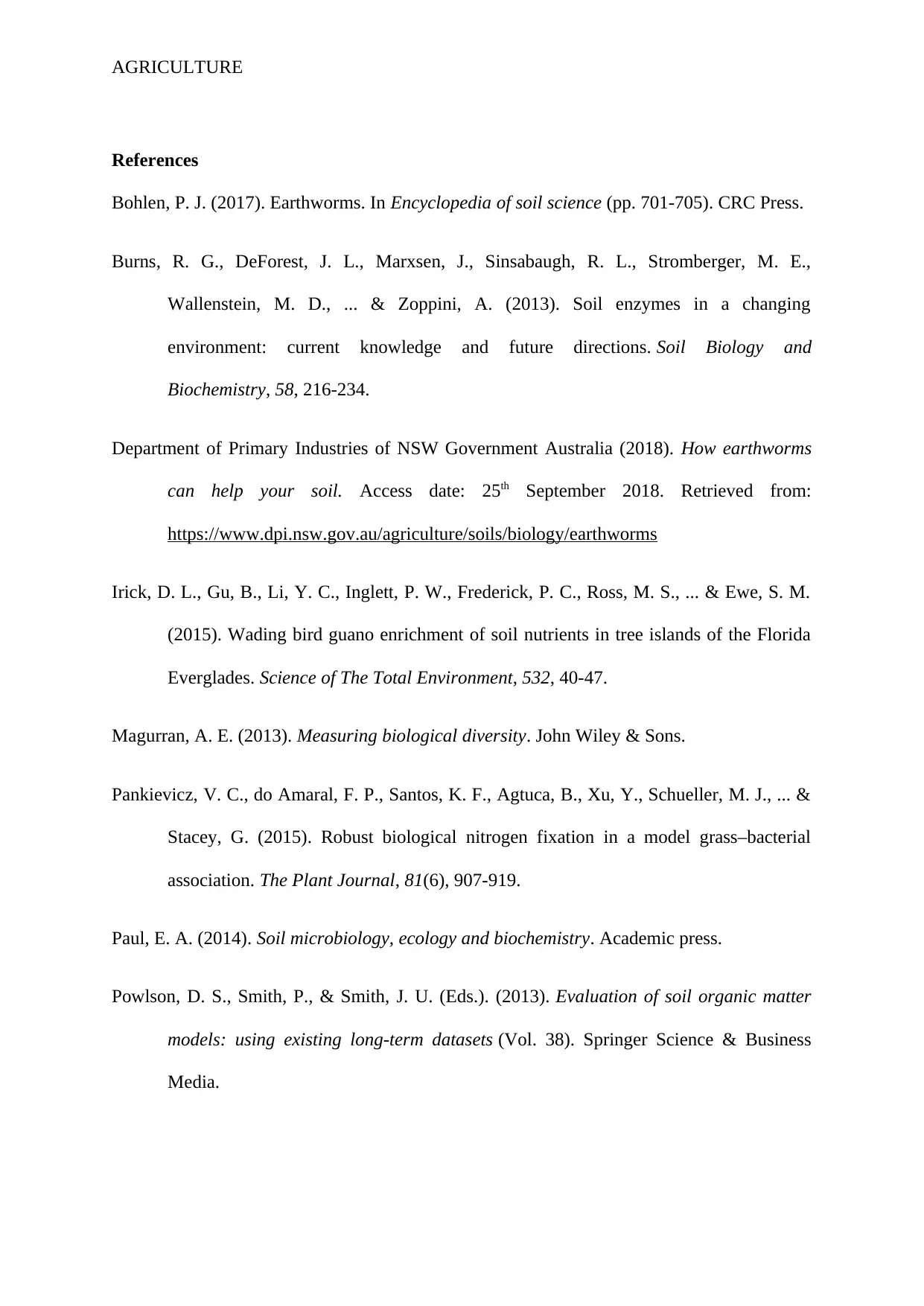
AGRICULTURE
References
Bohlen, P. J. (2017). Earthworms. In Encyclopedia of soil science (pp. 701-705). CRC Press.
Burns, R. G., DeForest, J. L., Marxsen, J., Sinsabaugh, R. L., Stromberger, M. E.,
Wallenstein, M. D., ... & Zoppini, A. (2013). Soil enzymes in a changing
environment: current knowledge and future directions. Soil Biology and
Biochemistry, 58, 216-234.
Department of Primary Industries of NSW Government Australia (2018). How earthworms
can help your soil. Access date: 25th September 2018. Retrieved from:
https://www.dpi.nsw.gov.au/agriculture/soils/biology/earthworms
Irick, D. L., Gu, B., Li, Y. C., Inglett, P. W., Frederick, P. C., Ross, M. S., ... & Ewe, S. M.
(2015). Wading bird guano enrichment of soil nutrients in tree islands of the Florida
Everglades. Science of The Total Environment, 532, 40-47.
Magurran, A. E. (2013). Measuring biological diversity. John Wiley & Sons.
Pankievicz, V. C., do Amaral, F. P., Santos, K. F., Agtuca, B., Xu, Y., Schueller, M. J., ... &
Stacey, G. (2015). Robust biological nitrogen fixation in a model grass–bacterial
association. The Plant Journal, 81(6), 907-919.
Paul, E. A. (2014). Soil microbiology, ecology and biochemistry. Academic press.
Powlson, D. S., Smith, P., & Smith, J. U. (Eds.). (2013). Evaluation of soil organic matter
models: using existing long-term datasets (Vol. 38). Springer Science & Business
Media.
References
Bohlen, P. J. (2017). Earthworms. In Encyclopedia of soil science (pp. 701-705). CRC Press.
Burns, R. G., DeForest, J. L., Marxsen, J., Sinsabaugh, R. L., Stromberger, M. E.,
Wallenstein, M. D., ... & Zoppini, A. (2013). Soil enzymes in a changing
environment: current knowledge and future directions. Soil Biology and
Biochemistry, 58, 216-234.
Department of Primary Industries of NSW Government Australia (2018). How earthworms
can help your soil. Access date: 25th September 2018. Retrieved from:
https://www.dpi.nsw.gov.au/agriculture/soils/biology/earthworms
Irick, D. L., Gu, B., Li, Y. C., Inglett, P. W., Frederick, P. C., Ross, M. S., ... & Ewe, S. M.
(2015). Wading bird guano enrichment of soil nutrients in tree islands of the Florida
Everglades. Science of The Total Environment, 532, 40-47.
Magurran, A. E. (2013). Measuring biological diversity. John Wiley & Sons.
Pankievicz, V. C., do Amaral, F. P., Santos, K. F., Agtuca, B., Xu, Y., Schueller, M. J., ... &
Stacey, G. (2015). Robust biological nitrogen fixation in a model grass–bacterial
association. The Plant Journal, 81(6), 907-919.
Paul, E. A. (2014). Soil microbiology, ecology and biochemistry. Academic press.
Powlson, D. S., Smith, P., & Smith, J. U. (Eds.). (2013). Evaluation of soil organic matter
models: using existing long-term datasets (Vol. 38). Springer Science & Business
Media.
⊘ This is a preview!⊘
Do you want full access?
Subscribe today to unlock all pages.

Trusted by 1+ million students worldwide

AGRICULTURE
1 out of 7
Related Documents
Your All-in-One AI-Powered Toolkit for Academic Success.
+13062052269
info@desklib.com
Available 24*7 on WhatsApp / Email
![[object Object]](/_next/static/media/star-bottom.7253800d.svg)
Unlock your academic potential
Copyright © 2020–2025 A2Z Services. All Rights Reserved. Developed and managed by ZUCOL.




